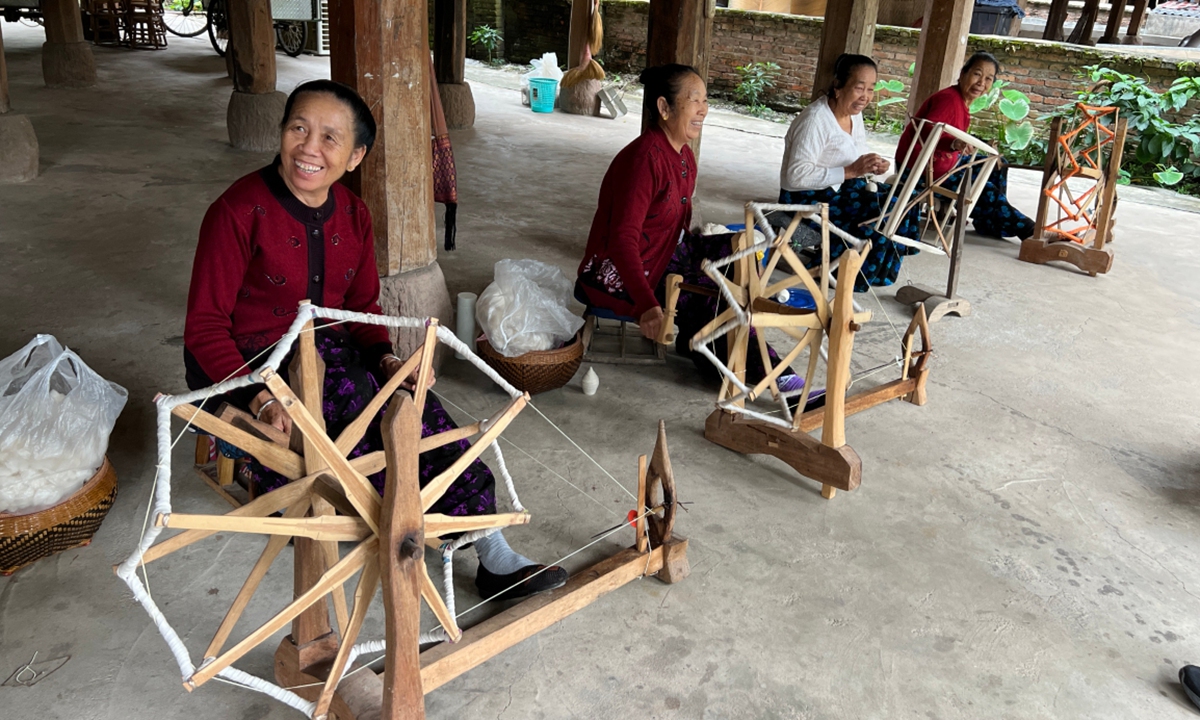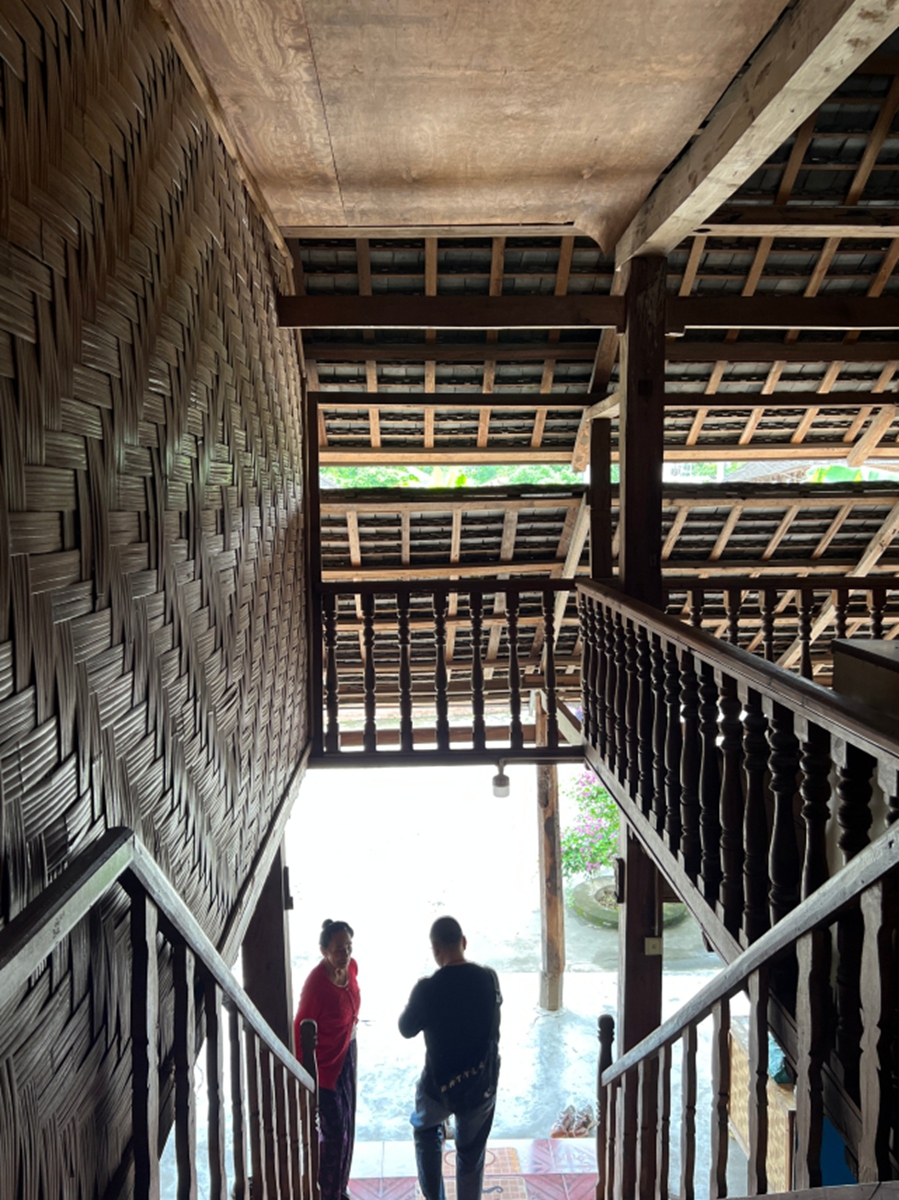
Dai ethnic women spin yarn with spinning wheels in Xishuangbanna, Southwest China's Yunnan Province. Photo: Lou Kang/GT
Near the China-Myanmar border, the Dai ethnic people of Southwest China's Yunnan Province have preserved their ancient survival skills for thousands of years. And now, they have fully adapted to the modern living with the help of both the government and the larger society, transforming their traditional villages into incredibly popular tourist attractions.
In the Xishuangbanna Dai Garden, which consists of five well-preserved traditional villages, native Dai people make a living from traditional crafts, such as weaving, carving, fabric dyeing and pottery.
Every morning, in the first floor of their typical stilted bamboo and wooden houses, looms come alive under the magical hands of professional weaving masters, who transform cotton yarn into various kinds of products for sale.
The Dai-produced brocade is a long strip of fabric made of wool, cotton, hemp, rayon, and a variety of other materials. By using the traditional wooden frame loom, such products have become an essential part in Dai religious rituals, and are also part of daily life.
The local residents told the Global Times that it takes about a week to make a laptop-sized handbag, and a month to make a beautiful shawl.
"No one knows how long these weaving machines and handicrafts have existed. We only know that these crafts have been passed down from generation to generation and will continue to be inherited," a local villager told the Global Times.

A square in the Xishuangbanna Dai Garden, Southwest China's Yunnan Province Photo: VCG
A living history
The Xishuangbanna Dai Garden is a 4A-level scenic spot located in Xishuangbanna Dai Autonomous Prefecture, Yunnan, a place where tradition and modernity intermingle, creating a tourist attraction that inspires visitors. It consists of five well-preserved traditional villages, namely Manting, Manfeng, Mani, Manlong and Manyuan.
The villagers have subsisted on handicraft making for generations. But these days, they also actively participate in the development of tourism, providing tourists with Dai-style accommodation, catering, entertainment, shopping options, and other services.
Nowadays, the garden is a scenic spot that not only showcases the elements of Dai history, culture, sports, construction, clothing and food, but is a glowing representation of rural tourism in Yunnan.
The history of the establishment of the Xishuangbanna Dai Garden can be traced back to the end of the last century, when the tourism industry in Xishuangbanna began to blossom, but the traditional culture and lifestyle of the Dai people faced imminent extinction.
In order to protect and inherit the cultural heritage of the Dai people, and also promote the economic development of the area, the Xishuangbanna prefecture government launched a project in 1998, integrating five traditional villages into a scenic spot named Xishuangbanna Dai Garden.
The project received strong support from the National Tourism Administration, the Yunnan Provincial Government, as well as the Yunnan Provincial Tourism Bureau.
After years of construction and improvement, the Xishuangbanna Dai Garden gradually became a popular tourist destination, attracting many domestic and foreign tourists, and also contributed to the dissemination of Dai culture as well as their economic growth.
"Every day there are around 6,500 tourists and our highest daily influx once reached 22,000 people," local guide Yu Binghan told the Global Times on Sunday.

People inside a building in the Xishuangbanna Dai Garden Photo: Lou Kang/GT
Protecting while touring
Looking out from the second floor of the residential building, the Gothic-like wooden spires and the clusters of banana plants and other economic crops outside complement each other harmoniously.
The local residents have made continuous efforts toward the preservation of their traditions as much as possible while developing the local economy.
The local guide told the Global Times that the structure of Dai houses has changed over time. "After the bamboo houses were gradually eliminated, wooden structures became the second generation of the most popular house type for the local residents, and later, people introduced reinforced concrete," Yu told the Global Times.
In order to better facilitate the tourists' in-depth experience, local residents vacate their wooden houses and open them to tourists at specific times every day.
Dai architecture, which is an expression of nature, not only adapts to it but also follows and blends with nature. The completely hollowed-out living room on both sides of the second floor greatly integrates nature and ecology into life.
"This is where the ancient Chinese garden reflects the national culture of 'harmony between human and nature,' which is the biggest feature that is independent of the world's forest, and also the fundamental reason for its artistic vitality. Dai architecture, as a unique architectural form, also has its unique artistic vitality," the guide explained.
Walking along the forest path, Dai bamboo houses appear in random formation along the path. The stilted square double-story buildings are simply villas typify the scenery, and are warm in the winter and cool in the summer.
"Walking here is like being in a living museum; every resident here is almost an intangible cultural heritage inheritor, because we live on these things and pass them on to the next generation," said Ai Yong, a young elephant foot drum dance inheritor.
URL: https://www.seeglobalnews.com/read-2718.html